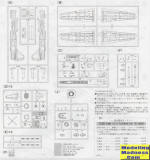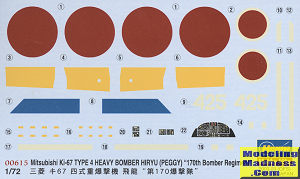
Hasegawa 1/72 Ki-67 Hiryu '170th Bomber Regiment'
| KIT #: | 00615 |
| PRICE: | 2600 yen SRP |
| DECALS: | Two options |
| REVIEWER: | Scott Van Aken |
| NOTES: | 2003 Limited Edition |

| HISTORY |
The Ki-67 was the result of a 1941 Japanese army specification for a successor to the Nakajima Ki-49 "storm dragon". This new aircraft was specified to be a high-speed twin-engined heavy bomber suitable for possible conflicts with the Soviet Union over the Manchuria-Siberia border, and unlike many Japanese warplanes, was required to have good defensive armament and the ability to survive heavy battle damage. It was also required to be highly maneuverable allowing it to carry out dive-bombing attacks and escape at low level.
The Ki-67 was designed by a team led by Kyūnojō Ozawa, chief engineer at Mitsubishi, and was a mid-winged monoplane of all-metal construction, with a retractable tailwheel undercarriage. It was fitted with self-sealing fuel tanks and armor, features common in US fighters and bombers but frequently lacking in Japanese aircraft. With these features and its two 1,417 kW (1,900 hp) 18-cylinder air-cooled radial engines, the Ki-67 was perhaps one of the most sturdy and damage-resistant Japanese aircraft of World War II.
| THE KIT |
 Molding
is very typical of what one would expect from a new mold Hasegawa kit; it is
excellent. Also typical of Hasegawa, the six medium grey sprues are
all packaged together in the same bag. The clear bits and decal sheet are in
a separate bag. Rather than show you a composite of all the spures, I'm
going to start putting up (where appropriate) the parts layout drawing and a
representative section of the kit. As you can see, there are quite a few
bits and pieces in this kit. In addition, there are those interesting little
polycaps for the propeller shafts.
Molding
is very typical of what one would expect from a new mold Hasegawa kit; it is
excellent. Also typical of Hasegawa, the six medium grey sprues are
all packaged together in the same bag. The clear bits and decal sheet are in
a separate bag. Rather than show you a composite of all the spures, I'm
going to start putting up (where appropriate) the parts layout drawing and a
representative section of the kit. As you can see, there are quite a few
bits and pieces in this kit. In addition, there are those interesting little
polycaps for the propeller shafts.
Just on an aside, it was Tamiya that started that trend back with their 1/48 Rex floatplane, however Hasegawa is the one that has made the most use of this feature. If you remember their Ki-84 kit, it had a ton of them!
In terms of options, there are three major ones, all confined to the bomb bay area. You can have it with doors closed. You can have it with doors open and Ta-bombs (whatever they are) installed. Or you can have it with doors off and the torpedo installed. There is also a radar set up, but that isn't used in this boxing. Should you wish the aft fuselage guns in the extended position, you have to cut off the rear of the side clear blisters. When I built this kit I did not do that and kept them stowed. modelers will do that!
The cockpit section is quite detailed with full crew positions and the fuselage fuel tank. How much can be seen after construction is unknown, but that doesn't stop real modelers from detailing those areas, does it?? You'll also be glad to know that though no crew members are included, Hasegawa does do a nice set that you can add to your kit if you so wish.
 Instructions
are standard Hasegawa fare. While there are two markings options, they seem to
be the same plane. One is with the standard tail markings for the unit while the
other has the fin/rudder painted white as on the box art. There is a photo of
this plane on Wiki. Upper surface colors are a dark brown which needs to be
mixed. The underside is shown as a Mitsubishi green, but I think that should be
a green-grey. The decal sheet is nicely done and includes the wing leading edge
yellow bits.
Instructions
are standard Hasegawa fare. While there are two markings options, they seem to
be the same plane. One is with the standard tail markings for the unit while the
other has the fin/rudder painted white as on the box art. There is a photo of
this plane on Wiki. Upper surface colors are a dark brown which needs to be
mixed. The underside is shown as a Mitsubishi green, but I think that should be
a green-grey. The decal sheet is nicely done and includes the wing leading edge
yellow bits.
| CONCLUSIONS |
First thing you should do before starting this kit is to get a masking set for this one, otherwise you will spend a lot of your building time masking. Secondly, when I built one of these, I noted that the nose transparency was a bit larger than the nose of the fuselage. The rest of the kit went together with little fuss and looks great on my shelf.
| REFERENCES |
https://en.wikipedia.org/wiki/Mitsubishi_Ki-67
May 2021 Copyright ModelingMadness.com. All rights
reserved. No reproduction without express permission. If you would like your product reviewed fairly and fairly quickly, please contact the editor or see other details in the
Note to
Contributors.